Debate: Designing and Implementing Customer Centric Banking Model
VerifiedAdded on 2023/06/18
|6
|1700
|212
Essay
AI Summary
This essay presents a debate on the design and implementation of a customer-centric business model in the banking sector, viewed from the perspective of a Financial Ombudsman. It addresses the need for banks to develop a comprehensive understanding of their dynamic customer base and simplify their products to enhance customer experience. The debate covers points and counterpoints, including the importance of operationalizing customer empathy, the cost implications of customer-centric models, and the role of employee training and artificial intelligence. The essay also emphasizes setting effective communication channels with customers and gathering regular feedback to improve banking products and services. References to academic journals and online resources support the arguments presented, highlighting the complexities and benefits of adopting a customer-centric approach in the banking industry. Desklib offers this assignment, along with a wealth of study tools, to support students' learning.
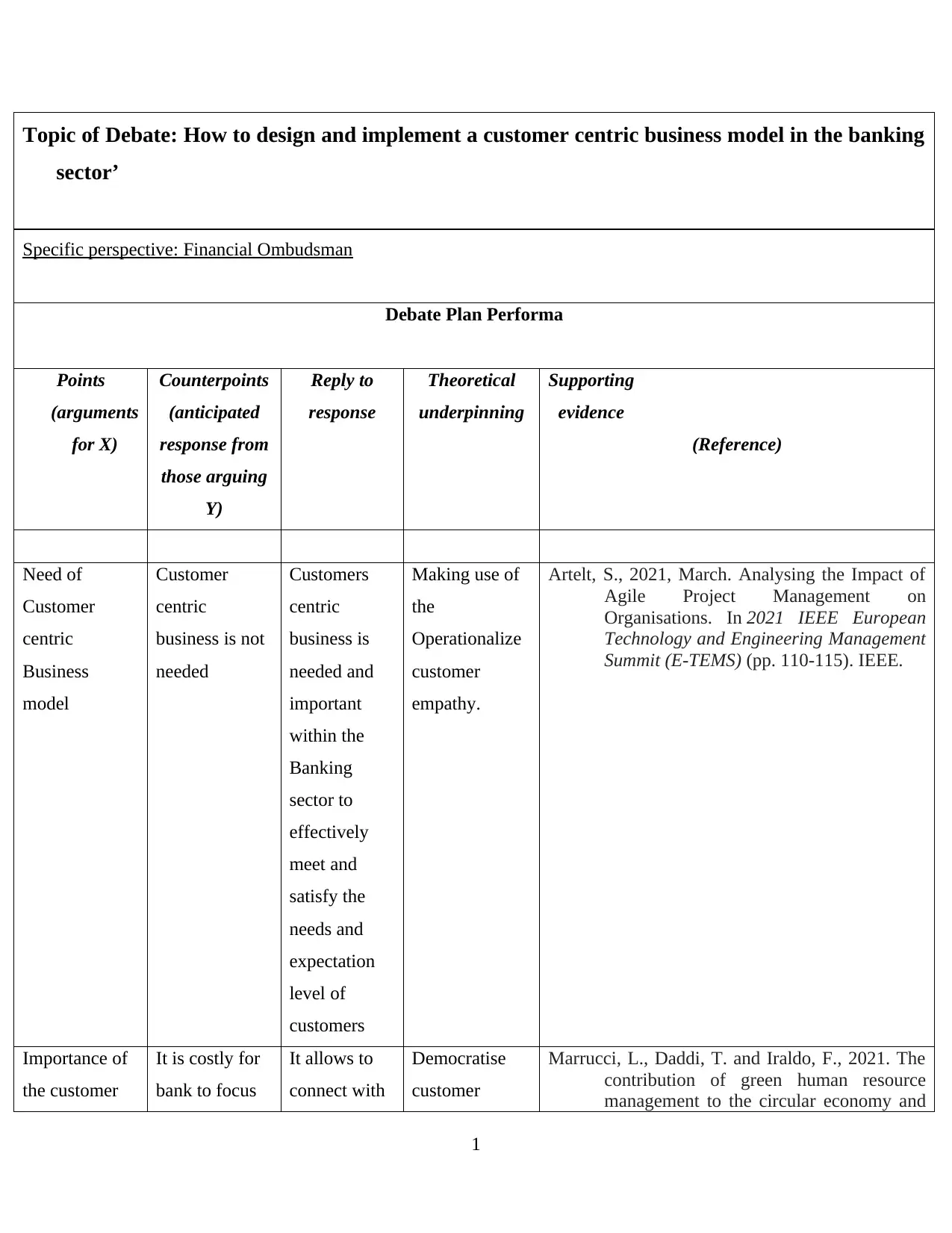
Topic of Debate: How to design and implement a customer centric business model in the banking
sector’
Specific perspective: Financial Ombudsman
Debate Plan Performa
Points
(arguments
for X)
Counterpoints
(anticipated
response from
those arguing
Y)
Reply to
response
Theoretical
underpinning
Supporting
evidence
(Reference)
Need of
Customer
centric
Business
model
Customer
centric
business is not
needed
Customers
centric
business is
needed and
important
within the
Banking
sector to
effectively
meet and
satisfy the
needs and
expectation
level of
customers
Making use of
the
Operationalize
customer
empathy.
Artelt, S., 2021, March. Analysing the Impact of
Agile Project Management on
Organisations. In 2021 IEEE European
Technology and Engineering Management
Summit (E-TEMS) (pp. 110-115). IEEE.
Importance of
the customer
It is costly for
bank to focus
It allows to
connect with
Democratise
customer
Marrucci, L., Daddi, T. and Iraldo, F., 2021. The
contribution of green human resource
management to the circular economy and
1
sector’
Specific perspective: Financial Ombudsman
Debate Plan Performa
Points
(arguments
for X)
Counterpoints
(anticipated
response from
those arguing
Y)
Reply to
response
Theoretical
underpinning
Supporting
evidence
(Reference)
Need of
Customer
centric
Business
model
Customer
centric
business is not
needed
Customers
centric
business is
needed and
important
within the
Banking
sector to
effectively
meet and
satisfy the
needs and
expectation
level of
customers
Making use of
the
Operationalize
customer
empathy.
Artelt, S., 2021, March. Analysing the Impact of
Agile Project Management on
Organisations. In 2021 IEEE European
Technology and Engineering Management
Summit (E-TEMS) (pp. 110-115). IEEE.
Importance of
the customer
It is costly for
bank to focus
It allows to
connect with
Democratise
customer
Marrucci, L., Daddi, T. and Iraldo, F., 2021. The
contribution of green human resource
management to the circular economy and
1
Secure Best Marks with AI Grader
Need help grading? Try our AI Grader for instant feedback on your assignments.
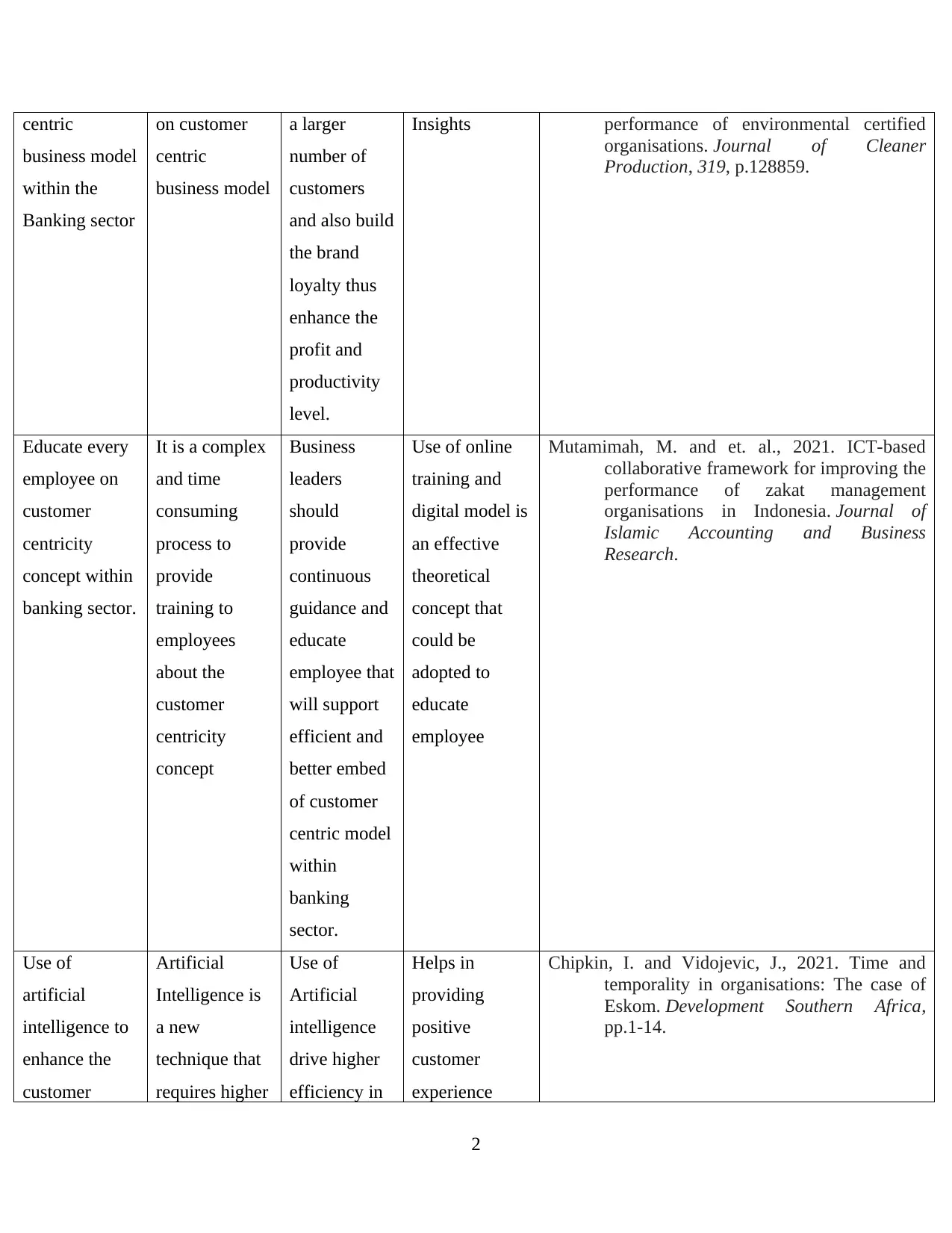
centric
business model
within the
Banking sector
on customer
centric
business model
a larger
number of
customers
and also build
the brand
loyalty thus
enhance the
profit and
productivity
level.
Insights performance of environmental certified
organisations. Journal of Cleaner
Production, 319, p.128859.
Educate every
employee on
customer
centricity
concept within
banking sector.
It is a complex
and time
consuming
process to
provide
training to
employees
about the
customer
centricity
concept
Business
leaders
should
provide
continuous
guidance and
educate
employee that
will support
efficient and
better embed
of customer
centric model
within
banking
sector.
Use of online
training and
digital model is
an effective
theoretical
concept that
could be
adopted to
educate
employee
Mutamimah, M. and et. al., 2021. ICT-based
collaborative framework for improving the
performance of zakat management
organisations in Indonesia. Journal of
Islamic Accounting and Business
Research.
Use of
artificial
intelligence to
enhance the
customer
Artificial
Intelligence is
a new
technique that
requires higher
Use of
Artificial
intelligence
drive higher
efficiency in
Helps in
providing
positive
customer
experience
Chipkin, I. and Vidojevic, J., 2021. Time and
temporality in organisations: The case of
Eskom. Development Southern Africa,
pp.1-14.
2
business model
within the
Banking sector
on customer
centric
business model
a larger
number of
customers
and also build
the brand
loyalty thus
enhance the
profit and
productivity
level.
Insights performance of environmental certified
organisations. Journal of Cleaner
Production, 319, p.128859.
Educate every
employee on
customer
centricity
concept within
banking sector.
It is a complex
and time
consuming
process to
provide
training to
employees
about the
customer
centricity
concept
Business
leaders
should
provide
continuous
guidance and
educate
employee that
will support
efficient and
better embed
of customer
centric model
within
banking
sector.
Use of online
training and
digital model is
an effective
theoretical
concept that
could be
adopted to
educate
employee
Mutamimah, M. and et. al., 2021. ICT-based
collaborative framework for improving the
performance of zakat management
organisations in Indonesia. Journal of
Islamic Accounting and Business
Research.
Use of
artificial
intelligence to
enhance the
customer
Artificial
Intelligence is
a new
technique that
requires higher
Use of
Artificial
intelligence
drive higher
efficiency in
Helps in
providing
positive
customer
experience
Chipkin, I. and Vidojevic, J., 2021. Time and
temporality in organisations: The case of
Eskom. Development Southern Africa,
pp.1-14.
2
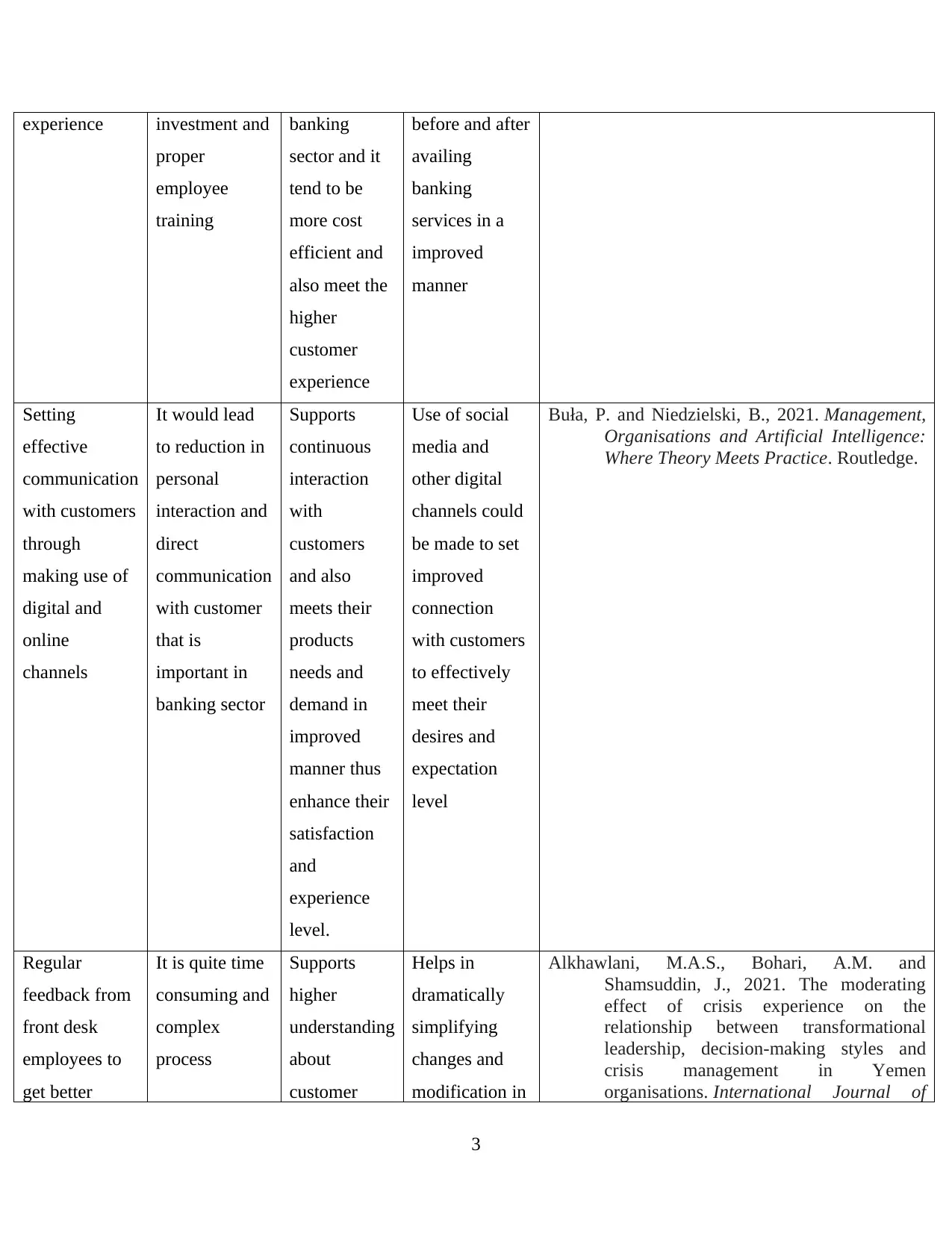
experience investment and
proper
employee
training
banking
sector and it
tend to be
more cost
efficient and
also meet the
higher
customer
experience
before and after
availing
banking
services in a
improved
manner
Setting
effective
communication
with customers
through
making use of
digital and
online
channels
It would lead
to reduction in
personal
interaction and
direct
communication
with customer
that is
important in
banking sector
Supports
continuous
interaction
with
customers
and also
meets their
products
needs and
demand in
improved
manner thus
enhance their
satisfaction
and
experience
level.
Use of social
media and
other digital
channels could
be made to set
improved
connection
with customers
to effectively
meet their
desires and
expectation
level
Buła, P. and Niedzielski, B., 2021. Management,
Organisations and Artificial Intelligence:
Where Theory Meets Practice. Routledge.
Regular
feedback from
front desk
employees to
get better
It is quite time
consuming and
complex
process
Supports
higher
understanding
about
customer
Helps in
dramatically
simplifying
changes and
modification in
Alkhawlani, M.A.S., Bohari, A.M. and
Shamsuddin, J., 2021. The moderating
effect of crisis experience on the
relationship between transformational
leadership, decision-making styles and
crisis management in Yemen
organisations. International Journal of
3
proper
employee
training
banking
sector and it
tend to be
more cost
efficient and
also meet the
higher
customer
experience
before and after
availing
banking
services in a
improved
manner
Setting
effective
communication
with customers
through
making use of
digital and
online
channels
It would lead
to reduction in
personal
interaction and
direct
communication
with customer
that is
important in
banking sector
Supports
continuous
interaction
with
customers
and also
meets their
products
needs and
demand in
improved
manner thus
enhance their
satisfaction
and
experience
level.
Use of social
media and
other digital
channels could
be made to set
improved
connection
with customers
to effectively
meet their
desires and
expectation
level
Buła, P. and Niedzielski, B., 2021. Management,
Organisations and Artificial Intelligence:
Where Theory Meets Practice. Routledge.
Regular
feedback from
front desk
employees to
get better
It is quite time
consuming and
complex
process
Supports
higher
understanding
about
customer
Helps in
dramatically
simplifying
changes and
modification in
Alkhawlani, M.A.S., Bohari, A.M. and
Shamsuddin, J., 2021. The moderating
effect of crisis experience on the
relationship between transformational
leadership, decision-making styles and
crisis management in Yemen
organisations. International Journal of
3
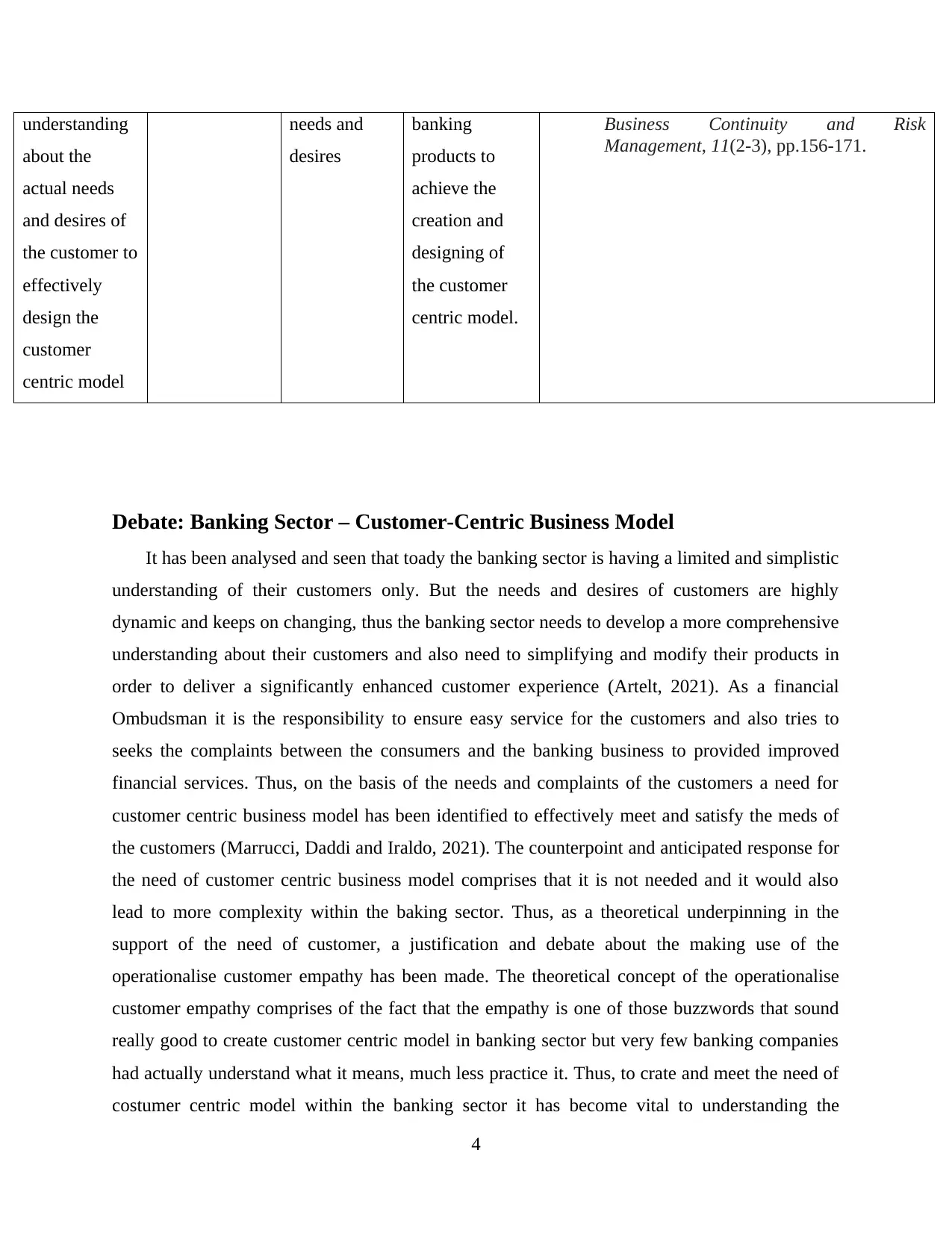
understanding
about the
actual needs
and desires of
the customer to
effectively
design the
customer
centric model
needs and
desires
banking
products to
achieve the
creation and
designing of
the customer
centric model.
Business Continuity and Risk
Management, 11(2-3), pp.156-171.
Debate: Banking Sector – Customer-Centric Business Model
It has been analysed and seen that toady the banking sector is having a limited and simplistic
understanding of their customers only. But the needs and desires of customers are highly
dynamic and keeps on changing, thus the banking sector needs to develop a more comprehensive
understanding about their customers and also need to simplifying and modify their products in
order to deliver a significantly enhanced customer experience (Artelt, 2021). As a financial
Ombudsman it is the responsibility to ensure easy service for the customers and also tries to
seeks the complaints between the consumers and the banking business to provided improved
financial services. Thus, on the basis of the needs and complaints of the customers a need for
customer centric business model has been identified to effectively meet and satisfy the meds of
the customers (Marrucci, Daddi and Iraldo, 2021). The counterpoint and anticipated response for
the need of customer centric business model comprises that it is not needed and it would also
lead to more complexity within the baking sector. Thus, as a theoretical underpinning in the
support of the need of customer, a justification and debate about the making use of the
operationalise customer empathy has been made. The theoretical concept of the operationalise
customer empathy comprises of the fact that the empathy is one of those buzzwords that sound
really good to create customer centric model in banking sector but very few banking companies
had actually understand what it means, much less practice it. Thus, to crate and meet the need of
costumer centric model within the banking sector it has become vital to understanding the
4
about the
actual needs
and desires of
the customer to
effectively
design the
customer
centric model
needs and
desires
banking
products to
achieve the
creation and
designing of
the customer
centric model.
Business Continuity and Risk
Management, 11(2-3), pp.156-171.
Debate: Banking Sector – Customer-Centric Business Model
It has been analysed and seen that toady the banking sector is having a limited and simplistic
understanding of their customers only. But the needs and desires of customers are highly
dynamic and keeps on changing, thus the banking sector needs to develop a more comprehensive
understanding about their customers and also need to simplifying and modify their products in
order to deliver a significantly enhanced customer experience (Artelt, 2021). As a financial
Ombudsman it is the responsibility to ensure easy service for the customers and also tries to
seeks the complaints between the consumers and the banking business to provided improved
financial services. Thus, on the basis of the needs and complaints of the customers a need for
customer centric business model has been identified to effectively meet and satisfy the meds of
the customers (Marrucci, Daddi and Iraldo, 2021). The counterpoint and anticipated response for
the need of customer centric business model comprises that it is not needed and it would also
lead to more complexity within the baking sector. Thus, as a theoretical underpinning in the
support of the need of customer, a justification and debate about the making use of the
operationalise customer empathy has been made. The theoretical concept of the operationalise
customer empathy comprises of the fact that the empathy is one of those buzzwords that sound
really good to create customer centric model in banking sector but very few banking companies
had actually understand what it means, much less practice it. Thus, to crate and meet the need of
costumer centric model within the banking sector it has become vital to understanding the
4
Secure Best Marks with AI Grader
Need help grading? Try our AI Grader for instant feedback on your assignments.
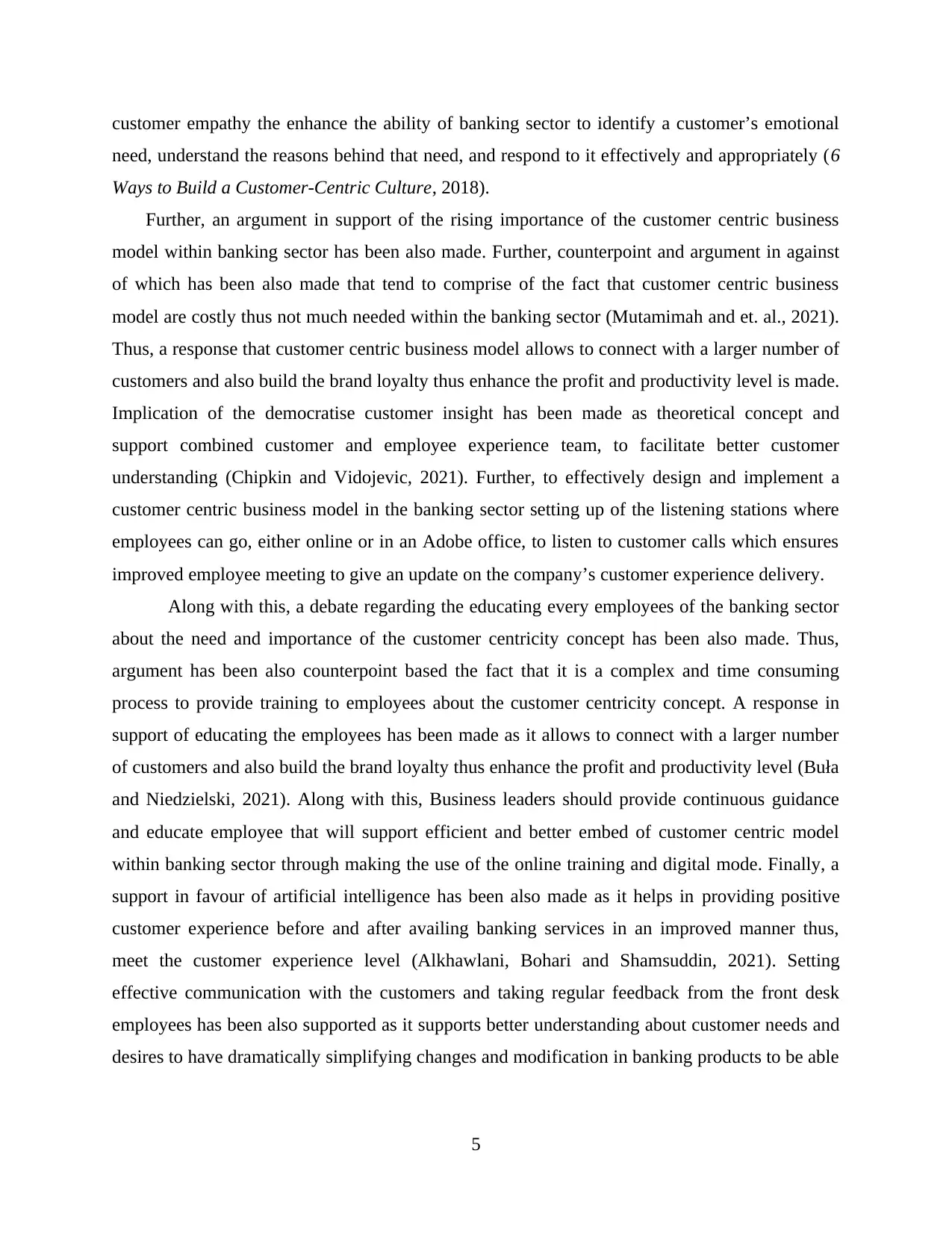
customer empathy the enhance the ability of banking sector to identify a customer’s emotional
need, understand the reasons behind that need, and respond to it effectively and appropriately (6
Ways to Build a Customer-Centric Culture, 2018).
Further, an argument in support of the rising importance of the customer centric business
model within banking sector has been also made. Further, counterpoint and argument in against
of which has been also made that tend to comprise of the fact that customer centric business
model are costly thus not much needed within the banking sector (Mutamimah and et. al., 2021).
Thus, a response that customer centric business model allows to connect with a larger number of
customers and also build the brand loyalty thus enhance the profit and productivity level is made.
Implication of the democratise customer insight has been made as theoretical concept and
support combined customer and employee experience team, to facilitate better customer
understanding (Chipkin and Vidojevic, 2021). Further, to effectively design and implement a
customer centric business model in the banking sector setting up of the listening stations where
employees can go, either online or in an Adobe office, to listen to customer calls which ensures
improved employee meeting to give an update on the company’s customer experience delivery.
Along with this, a debate regarding the educating every employees of the banking sector
about the need and importance of the customer centricity concept has been also made. Thus,
argument has been also counterpoint based the fact that it is a complex and time consuming
process to provide training to employees about the customer centricity concept. A response in
support of educating the employees has been made as it allows to connect with a larger number
of customers and also build the brand loyalty thus enhance the profit and productivity level (Buła
and Niedzielski, 2021). Along with this, Business leaders should provide continuous guidance
and educate employee that will support efficient and better embed of customer centric model
within banking sector through making the use of the online training and digital mode. Finally, a
support in favour of artificial intelligence has been also made as it helps in providing positive
customer experience before and after availing banking services in an improved manner thus,
meet the customer experience level (Alkhawlani, Bohari and Shamsuddin, 2021). Setting
effective communication with the customers and taking regular feedback from the front desk
employees has been also supported as it supports better understanding about customer needs and
desires to have dramatically simplifying changes and modification in banking products to be able
5
need, understand the reasons behind that need, and respond to it effectively and appropriately (6
Ways to Build a Customer-Centric Culture, 2018).
Further, an argument in support of the rising importance of the customer centric business
model within banking sector has been also made. Further, counterpoint and argument in against
of which has been also made that tend to comprise of the fact that customer centric business
model are costly thus not much needed within the banking sector (Mutamimah and et. al., 2021).
Thus, a response that customer centric business model allows to connect with a larger number of
customers and also build the brand loyalty thus enhance the profit and productivity level is made.
Implication of the democratise customer insight has been made as theoretical concept and
support combined customer and employee experience team, to facilitate better customer
understanding (Chipkin and Vidojevic, 2021). Further, to effectively design and implement a
customer centric business model in the banking sector setting up of the listening stations where
employees can go, either online or in an Adobe office, to listen to customer calls which ensures
improved employee meeting to give an update on the company’s customer experience delivery.
Along with this, a debate regarding the educating every employees of the banking sector
about the need and importance of the customer centricity concept has been also made. Thus,
argument has been also counterpoint based the fact that it is a complex and time consuming
process to provide training to employees about the customer centricity concept. A response in
support of educating the employees has been made as it allows to connect with a larger number
of customers and also build the brand loyalty thus enhance the profit and productivity level (Buła
and Niedzielski, 2021). Along with this, Business leaders should provide continuous guidance
and educate employee that will support efficient and better embed of customer centric model
within banking sector through making the use of the online training and digital mode. Finally, a
support in favour of artificial intelligence has been also made as it helps in providing positive
customer experience before and after availing banking services in an improved manner thus,
meet the customer experience level (Alkhawlani, Bohari and Shamsuddin, 2021). Setting
effective communication with the customers and taking regular feedback from the front desk
employees has been also supported as it supports better understanding about customer needs and
desires to have dramatically simplifying changes and modification in banking products to be able
5
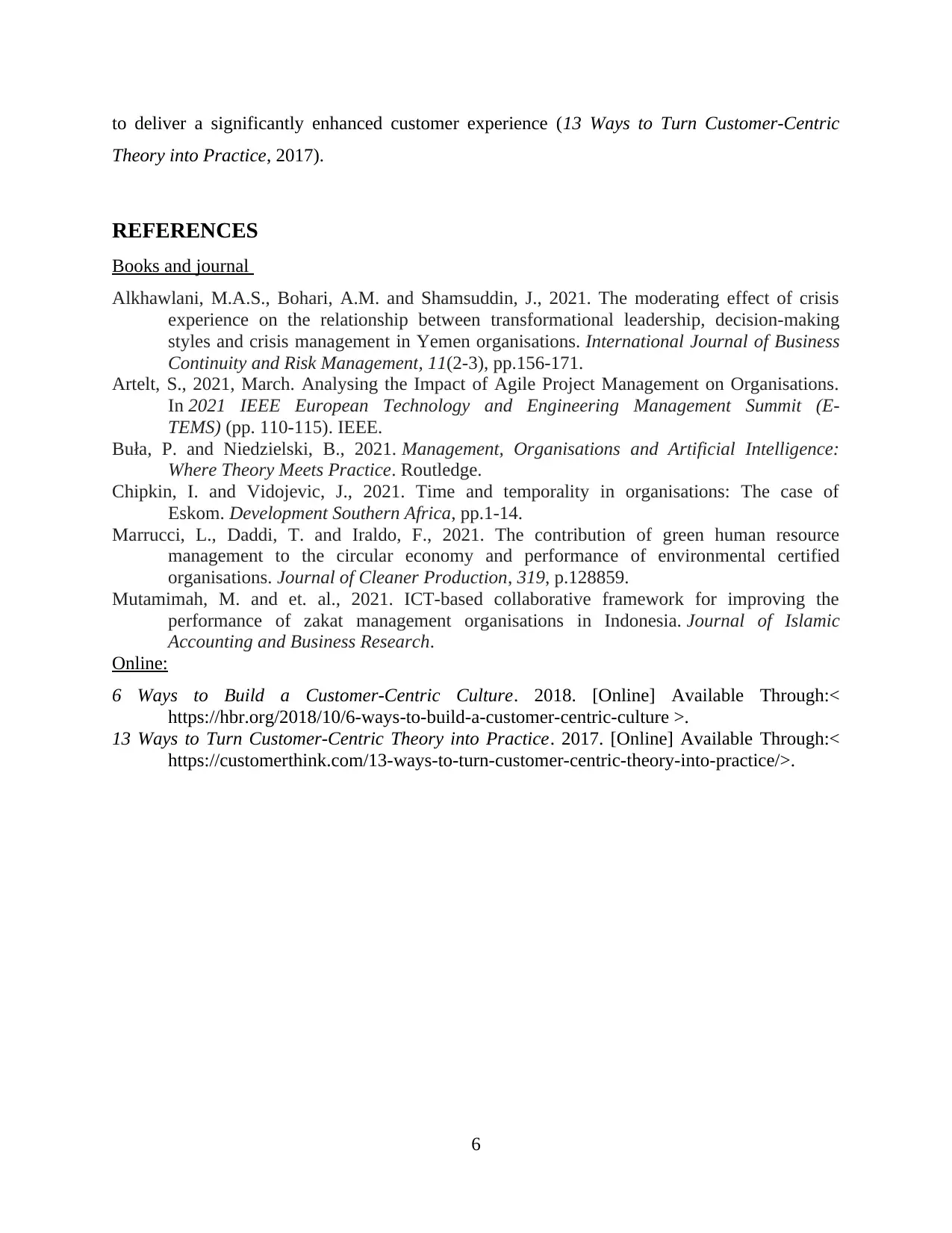
to deliver a significantly enhanced customer experience (13 Ways to Turn Customer-Centric
Theory into Practice, 2017).
REFERENCES
Books and journal
Alkhawlani, M.A.S., Bohari, A.M. and Shamsuddin, J., 2021. The moderating effect of crisis
experience on the relationship between transformational leadership, decision-making
styles and crisis management in Yemen organisations. International Journal of Business
Continuity and Risk Management, 11(2-3), pp.156-171.
Artelt, S., 2021, March. Analysing the Impact of Agile Project Management on Organisations.
In 2021 IEEE European Technology and Engineering Management Summit (E-
TEMS) (pp. 110-115). IEEE.
Buła, P. and Niedzielski, B., 2021. Management, Organisations and Artificial Intelligence:
Where Theory Meets Practice. Routledge.
Chipkin, I. and Vidojevic, J., 2021. Time and temporality in organisations: The case of
Eskom. Development Southern Africa, pp.1-14.
Marrucci, L., Daddi, T. and Iraldo, F., 2021. The contribution of green human resource
management to the circular economy and performance of environmental certified
organisations. Journal of Cleaner Production, 319, p.128859.
Mutamimah, M. and et. al., 2021. ICT-based collaborative framework for improving the
performance of zakat management organisations in Indonesia. Journal of Islamic
Accounting and Business Research.
Online:
6 Ways to Build a Customer-Centric Culture. 2018. [Online] Available Through:<
https://hbr.org/2018/10/6-ways-to-build-a-customer-centric-culture >.
13 Ways to Turn Customer-Centric Theory into Practice. 2017. [Online] Available Through:<
https://customerthink.com/13-ways-to-turn-customer-centric-theory-into-practice/>.
6
Theory into Practice, 2017).
REFERENCES
Books and journal
Alkhawlani, M.A.S., Bohari, A.M. and Shamsuddin, J., 2021. The moderating effect of crisis
experience on the relationship between transformational leadership, decision-making
styles and crisis management in Yemen organisations. International Journal of Business
Continuity and Risk Management, 11(2-3), pp.156-171.
Artelt, S., 2021, March. Analysing the Impact of Agile Project Management on Organisations.
In 2021 IEEE European Technology and Engineering Management Summit (E-
TEMS) (pp. 110-115). IEEE.
Buła, P. and Niedzielski, B., 2021. Management, Organisations and Artificial Intelligence:
Where Theory Meets Practice. Routledge.
Chipkin, I. and Vidojevic, J., 2021. Time and temporality in organisations: The case of
Eskom. Development Southern Africa, pp.1-14.
Marrucci, L., Daddi, T. and Iraldo, F., 2021. The contribution of green human resource
management to the circular economy and performance of environmental certified
organisations. Journal of Cleaner Production, 319, p.128859.
Mutamimah, M. and et. al., 2021. ICT-based collaborative framework for improving the
performance of zakat management organisations in Indonesia. Journal of Islamic
Accounting and Business Research.
Online:
6 Ways to Build a Customer-Centric Culture. 2018. [Online] Available Through:<
https://hbr.org/2018/10/6-ways-to-build-a-customer-centric-culture >.
13 Ways to Turn Customer-Centric Theory into Practice. 2017. [Online] Available Through:<
https://customerthink.com/13-ways-to-turn-customer-centric-theory-into-practice/>.
6
1 out of 6
Related Documents
Your All-in-One AI-Powered Toolkit for Academic Success.
+13062052269
info@desklib.com
Available 24*7 on WhatsApp / Email
![[object Object]](/_next/static/media/star-bottom.7253800d.svg)
Unlock your academic potential
© 2024 | Zucol Services PVT LTD | All rights reserved.




